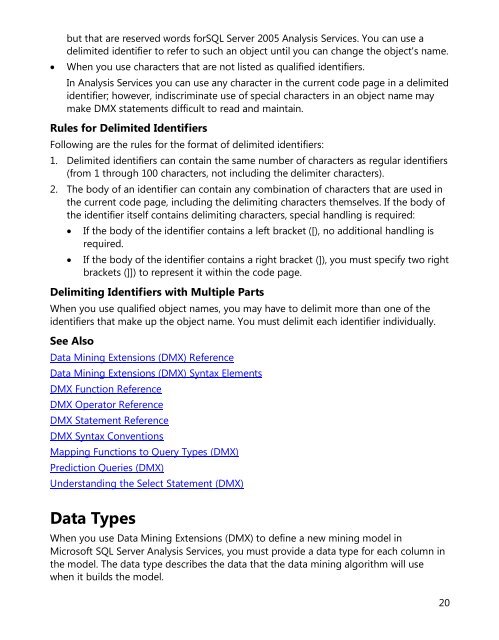Data Mining Extensions - DMX - Reference
Create successful ePaper yourself
Turn your PDF publications into a flip-book with our unique Google optimized e-Paper software.
ut that are reserved words forSQL Server 2005 Analysis Services. You can use a<br />
delimited identifier to refer to such an object until you can change the object's name.<br />
• When you use characters that are not listed as qualified identifiers.<br />
In Analysis Services you can use any character in the current code page in a delimited<br />
identifier; however, indiscriminate use of special characters in an object name may<br />
make <strong>DMX</strong> statements difficult to read and maintain.<br />
Rules for Delimited Identifiers<br />
Following are the rules for the format of delimited identifiers:<br />
1. Delimited identifiers can contain the same number of characters as regular identifiers<br />
(from 1 through 100 characters, not including the delimiter characters).<br />
2. The body of an identifier can contain any combination of characters that are used in<br />
the current code page, including the delimiting characters themselves. If the body of<br />
the identifier itself contains delimiting characters, special handling is required:<br />
• If the body of the identifier contains a left bracket ([), no additional handling is<br />
required.<br />
• If the body of the identifier contains a right bracket (]), you must specify two right<br />
brackets (]]) to represent it within the code page.<br />
Delimiting Identifiers with Multiple Parts<br />
When you use qualified object names, you may have to delimit more than one of the<br />
identifiers that make up the object name. You must delimit each identifier individually.<br />
See Also<br />
<strong>Data</strong> <strong>Mining</strong> <strong>Extensions</strong> (<strong>DMX</strong>) <strong>Reference</strong><br />
<strong>Data</strong> <strong>Mining</strong> <strong>Extensions</strong> (<strong>DMX</strong>) Syntax Elements<br />
<strong>DMX</strong> Function <strong>Reference</strong><br />
<strong>DMX</strong> Operator <strong>Reference</strong><br />
<strong>DMX</strong> Statement <strong>Reference</strong><br />
<strong>DMX</strong> Syntax Conventions<br />
Mapping Functions to Query Types (<strong>DMX</strong>)<br />
Prediction Queries (<strong>DMX</strong>)<br />
Understanding the Select Statement (<strong>DMX</strong>)<br />
<strong>Data</strong> Types<br />
When you use <strong>Data</strong> <strong>Mining</strong> <strong>Extensions</strong> (<strong>DMX</strong>) to define a new mining model in<br />
Microsoft SQL Server Analysis Services, you must provide a data type for each column in<br />
the model. The data type describes the data that the data mining algorithm will use<br />
when it builds the model.<br />
20









